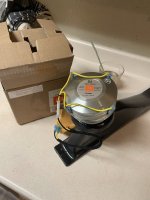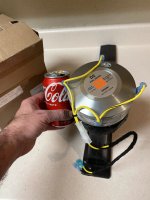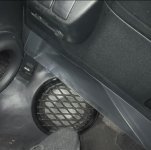There is so many questions that just comes back. Thats ok for me since repetition is good for the memory to stick.The answer was only a few pages back on the same topic
https://www.diyaudio.com/community/...eq-and-fir-filtering-tool.221434/post-7007247
View attachment 1220907
I have seen older tutorials (5 years or so) but since there is a lot of new features and functions in REW and Rephase. Is there a more up to date instruction on how to optimize sound both for sub aligning, frequency response, and impulse response? Or is it recommended to run DIRAC and forget about fiddling around?
I can understand why a tutorial is appealing, but for me none of the ones I have seen would be the way I would approach it. Trying to get existing speakers in a room to sound better through processing is still as much an art as it is a science. Painting by numbers isn't the right way. Hammering the response to a target curve makes for nice graphs and most likely dissapointing sound. Each speaker and room is different and will benefit from a slightly different type of processing.I have seen older tutorials (5 years or so) but since there is a lot of new features and functions in REW and Rephase. Is there a more up to date instruction on how to optimize sound both for sub aligning, frequency response, and impulse response? Or is it recommended to run DIRAC and forget about fiddling around?
If researching, testing and tweaking doesn't appeal, DIRAC or similar might be worth a try, but with effort I think anyone can do better with free tools.
Agree that all setup is different and need diffrent approaches. Thats why I use dipoles which is good between 35-200Hz since they only excite room resonance in dimension. Then taking care of the first reflection, and try to reach a decent RT60.
But even with "perfect" setups, with acoustic treatment and 200k USD systems i have heard what DIRAC can do. And i agree that it is possible to do better with free tools if you know what to do and how to use the tools. That´s why I want to learn more, and a good start is tutorials.
But even with "perfect" setups, with acoustic treatment and 200k USD systems i have heard what DIRAC can do. And i agree that it is possible to do better with free tools if you know what to do and how to use the tools. That´s why I want to learn more, and a good start is tutorials.
As I read this, you have tried linear phase FIR crossovers and IIR Fir crossovers, both generated with Rephase?
No further phase EQ was done, the above was responsible for the messed up attack?
How did you align the drivers, to make sure they were time aligned at the listening spot?
The cause of delay was covered in previous posts, phase linearisation needs to have that delay in order to do it's work before the IR peak.
The center position makes sense in that case. Press play a little sooner to cover for that.
For the time alignment I tried to just line up the drivers with the woofer, a rough estimation of distance to time then playing with the time in small increments until I landed on something with the least issues visible on RTA. Any deviation from my current settings leads to dips in the response so I'd imagine I'm at least close. I measured the distances from the dome.
I'm a little lost on this one, but maybe some pictures help? Blue is linear phase filters. I did also export some new filters with settings shown in the previous posts to reduce delay but it just gives me the exact same delay as before. rephase says there's very, very little delay, but once it's in EQ APO it goes to 371ms.
For the time alignment I tried to just line up the drivers with the woofer, a rough estimation of distance to time then playing with the time in small increments until I landed on something with the least issues visible on RTA. Any deviation from my current settings leads to dips in the response so I'd imagine I'm at least close. I measured the distances from the dome.
I'm a little lost on this one, but maybe some pictures help? Blue is linear phase filters. I did also export some new filters with settings shown in the previous posts to reduce delay but it just gives me the exact same delay as before. rephase says there's very, very little delay, but once it's in EQ APO it goes to 371ms.
View attachment 1221295
View attachment 1221294
I'd still like to learn a bit more about what you did. Did you EQ the drivers flat past the crossover frequency before applying the linear phase filters?
Maybe you can post the measurement file that showed us this step, so we can take a look at what's going on before the peak.
As to the second part, with the delay (that's talking about the IIR case, right?), I don't have a clue yet. Moving the IR peak toward the beginning of the FIR file should have an immediate result in shortening the delay. I have no experience with EQ-Apo but I'd guess the FIR file is the cause.
For the time alignment I tried to just line up the drivers with the woofer, a rough estimation of distance to time then playing with the time in small increments until I landed on something with the least issues visible on RTA. Any deviation from my current settings leads to dips in the response so I'd imagine I'm at least close. I measured the distances from the dome.
I'm a little lost on this one, but maybe some pictures help? Blue is linear phase filters. I did also export some new filters with settings shown in the previous posts to reduce delay but it just gives me the exact same delay as before. rephase says there's very, very little delay, but once it's in EQ APO it goes to 371ms.
View attachment 1221295
View attachment 1221294
If you load all of your linear phase XO's in REW and then sum them, you should get perfect alignment.
Black plot is the sum of all of the individual LP XOs.
When you plot the LP sum, you get something like this if they are time aligned.
If you look at the overlayed linear phase XO STEP plots in REW (not the measurments, just the raw RePhase XOs), you will see how they align. Their zero crossing of the X-Axis all happen at the same place.
You will have to zoom in and out to verify this.
Being such, that is how I time align my linear phase drivers. Since the tweeter is the narrowest STEP, I use that as the baseline and align all other drivers to the Tweeter's zero crossing. This is much more precise than trying to align to a lower frequency driver. Aim small, miss small. =)
Last edited:
I was trying to find the right impulse export settings for rePhase to be fed into HFD. But I am not able to successfully import any of the generated impulse files into the FIR grid of HFD 
Was anybody able to find the correct settings to generate a file that is accepted by HFD correctly?
I was not able to find any documentation or resources online.
The general rule should be 4500 taps at a rate of 93750Hz generated as a .txt file according to the HFD manual.
I got to the point where I did not receive an error on import, but the file was not loaded either.
Thanks upfront!
Was anybody able to find the correct settings to generate a file that is accepted by HFD correctly?
I was not able to find any documentation or resources online.
The general rule should be 4500 taps at a rate of 93750Hz generated as a .txt file according to the HFD manual.
I got to the point where I did not receive an error on import, but the file was not loaded either.
Thanks upfront!
@r3forge
To get resolution to 10hz you would need 11,980.8 taps or 11,981 proper.
I’m not familiar with your convolution engine, although I help someone the other day and we had to use 32bit LPCM.wav and then we had to take the left and right impulses and merge them into a stereo track in audacity.
If yours is supposed to take a text file maybe try 32/64 bit float lines.txt , but that is floating point not fixed point…
If you need it in fixed point you might import it as a impulse response into another program and then convert it to PCM (although I am not sure that PCM can be in text, @pos would know)
Have you referred to the help manual in your convolution engine? Because that sample rate does not even exist in RePhase, so I don’t know what you’re trying to do you would have to build your filter at another sample rate and then maybe use audacity or SoX to convert it to the fir your after
You might also try the text file.FRD in RePhase, the .frd is just a text extension iirc altho I don’t know much about that
To get resolution to 10hz you would need 11,980.8 taps or 11,981 proper.
I’m not familiar with your convolution engine, although I help someone the other day and we had to use 32bit LPCM.wav and then we had to take the left and right impulses and merge them into a stereo track in audacity.
If yours is supposed to take a text file maybe try 32/64 bit float lines.txt , but that is floating point not fixed point…
If you need it in fixed point you might import it as a impulse response into another program and then convert it to PCM (although I am not sure that PCM can be in text, @pos would know)
Have you referred to the help manual in your convolution engine? Because that sample rate does not even exist in RePhase, so I don’t know what you’re trying to do you would have to build your filter at another sample rate and then maybe use audacity or SoX to convert it to the fir your after
You might also try the text file.FRD in RePhase, the .frd is just a text extension iirc altho I don’t know much about that
Just want to show off these custom horns I made for my car. These drivers sound killer in there and my home made horn sounds fantastic! Plays down to 300hz , and pattern control to 700. The nice thing is this driver has the motor force and enough cone area to push through the pattern flip and still sound pretty good as the horn becomes omnidirectional.
This JBL D2430H has become my favorite driver, the vocals are extremely powerful and tons and tons of detail….
I’m going to do some RePhase magic on them tonite…. What a good driver , I had it in my wife’s van on a different horn, this horn is shorter to accommodate for the larger exit instead of a 1” to 1.4” adapter that doesn’t work right…
It spits out so much lows I bet off the horn that driver would still play to 300 lol 😂..
it’s become my favorite driver, I like it more then the TAD-TD2001.
There is a radian 1.4 inch exit beryllium neodymium driver that looks extremely interesting but I’m glad I picked this one but I still want to try that radian.
RePhase for the win, I’m going to try to mimic the M2 crossover as much as the horn and car will let me…. I’ll post measurements as soon as I have them
Untuned and a few min by ear last nite after the install I’m impressed.

This JBL D2430H has become my favorite driver, the vocals are extremely powerful and tons and tons of detail….
I’m going to do some RePhase magic on them tonite…. What a good driver , I had it in my wife’s van on a different horn, this horn is shorter to accommodate for the larger exit instead of a 1” to 1.4” adapter that doesn’t work right…
It spits out so much lows I bet off the horn that driver would still play to 300 lol 😂..
it’s become my favorite driver, I like it more then the TAD-TD2001.
There is a radian 1.4 inch exit beryllium neodymium driver that looks extremely interesting but I’m glad I picked this one but I still want to try that radian.
RePhase for the win, I’m going to try to mimic the M2 crossover as much as the horn and car will let me…. I’ll post measurements as soon as I have them
Untuned and a few min by ear last nite after the install I’m impressed.
Attachments
I thought the da8 is 96k .Hello guys!
My unit (OpenDRC-DA8) gives me 9400 Taps at (48khz) Can i run a 12db 4-way on that?
Ex:
View attachment 1250404
If it is 9400 at 48k it’s plenty to do a 12db
I make 12db filters all the time with 1024 taps at 96k on 2x4HDs
That's the change in phase caused by the filter, and yes, it's better than pre-ringing. But please, try both and determine which you think sounds better. If you go back and read the almost 200 pages of this forum most of your questions will be answered.
Using a linear filter that low will create audible pre-ringing. I would recommend using the minimum phase filter.
May I disagree? You would get audible pre-ringing only if the arrival times are substantially different, which attention to path lengths and group delays for woofers to mids would mitigate.
FIRs are my preference below about 1 kHz: to me snare drums sound a bit wimpy with 4th order phase rotation at 250 Hz, and 4th order phase rotation somewhat muddles the distinction between kick drum and bass guitar, whereas I don't hear much difference on vocals or orchestral music. YMMV, of course.
- Home
- Design & Build
- Software Tools
- rePhase, a loudspeaker phase linearization, EQ and FIR filtering tool


